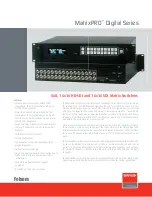
6
Access mode of VSIs
The VTEP supports VLAN access mode for VSIs. In VLAN access mode, Ethernet frames received
from or sent to the local site must contain 802.1Q VLAN tags.
•
For an Ethernet frame received from the local site, the VTEP removes all its 802.1Q VLAN tags
before forwarding the frame.
•
For an Ethernet frame destined for the local site, the VTEP adds 802.1Q VLAN tags to the
frame before forwarding the frame.
In VLAN access mode, VXLAN packets sent between sites do not contain 802.1Q VLAN tags. You
can use different 802.1Q VLANs to provide the same service in different sites.
ARP flood suppression
ARP flood suppression reduces ARP request broadcasts by enabling the VTEP to reply to ARP
requests on behalf of user terminals.
As shown in
, this feature snoops ARP packets to populate the ARP flood suppression table
with local and remote MAC addresses. If an ARP request has a matching entry, the VTEP replies to
the request on behalf of the user terminal. If no match is found, the VTEP floods the request to both
local and remote sites.
Figure 6 ARP flood suppression
ARP flood suppression uses the following workflow:
1.
Terminal 1 sends an ARP request to obtain the MAC address of Terminal 7.
2.
VTEP 1 creates a suppression entry for Terminal 1, and floods the ARP request in the VXLAN.
3.
VTEP 2 and VTEP 3 de-encapsulate the ARP request. The VTEPs create a suppression entry
for Terminal 1, and broadcast the request in the local site.
4.
Terminal 7 sends an ARP reply.
5.
VTEP 2 creates a suppression entry for Terminal 7 and forwards the ARP reply to VTEP 1.
(1)
VTEP 1
VTEP 2
Transport
network
P
Terminal 1
Terminal 2
Terminal 3
Terminal 7
Terminal 8
Terminal 9
Terminal 4
Terminal 5
Terminal 6
VX
LA
N tu
nne
l
VX
LA
N
tun
ne
l
VTEP 3
VXLAN tunnel
Terminal 10
Terminal 11
Terminal 12
(2)
(2)
(3)
(3)
(4)
(5)
(6)
(7)
(8)
(9)
(10)
(2)













































